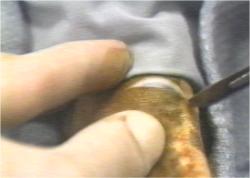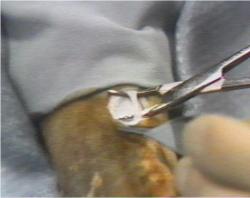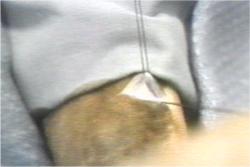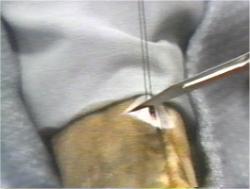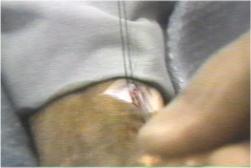|
|
|||||
IV CutdownSometimes, intravenous (IV) access is both important and not available by conventional means. In these cases, an IV cutdown may be useful. Three veins are most commonly used for IV cutdowns, the medial and lateral basilic veins in the antecubital fossa, and the X vein over the medial maleolus of the ankle. These veins are favored because:
Start by placing a tourniquet just above the cutdown site. It should be tight enough to obstruct venous flow back to the heart, but not so tight as to obstruct arterial flow out to the arm or leg. Inject local anesthetic just beneath the skin. 1% lidocaine works well for this purpose. Don't use too much volume as it will distort the normal anatomy and make the procedure more difficult. Make a 1-inch (in length) incision transversely across the skin overlying the vein. Don't go too deep (beyond the skin) or you may cut the vein. Use a curved hemostat to spread the subcutaneous tissues, parallel to the vein. Push in, spread, and release. The idea is to steadily (using 10 or 15 "spreads") release the vein from the surrounding tissues. After the vein is isolated from the surrounding tissues, use the curved hemostat to go underneath the vein. When you are finished, there should be about a half an inch of vein, free of any attachments. Slide two ligatures (threads or suture material) underneath the vein. Silk suture works well for this, but plain cotton thread can also be utilized. One of the ligatures is for the proximal (toward the heart) part of the vein; the other is for the distal (away from the heart) part of the vein. Tie the distal vein off, but hold onto the tail ends of the ligature to use as traction for the rest of the procedure. Lift up (a little) on the proximal ligature. This will elevate the vein and also occlude it so that there won't be any back-bleeding. Cut about half-way through the vein. Use a fine scissors or a scalpel for this. This is the delicate part of the procedure, because if you accidentally cut all the way through the vein, you will lose it and won't be able to continue with the IV cutdown at this site.
Slip the IV catheter through the opening you just made in the vein, aiming it into the proximal side, toward the heart. When it reaches the kink made by the ligature, you will need to briefly release the tension to allow the catheter to pass.
Once the IV catheter is in the vein and advanced as far as you want it to go, tie the proximal ligature around the vein and the catheter, securely fastening the catheter in place. Don't make it so tight, however, that you occlude the catheter. Connect IV tubing to the IV catheter and start your infusion. Don't forget to release the tourniquet. Suture the skin together with a few interrupted sutures. Then suture the IV catheter to the skin so that it will likely remain in place, even if accidentally tugged on. Apply sterile dressings. Watch a video showing this technique.
This section developed from A1701-73-0516V, "Venous Cutdown," Health Sciences Media Division, US Army Medical Department C&S, Fort Sam Houston, Texas
Home · Military Medicine · Sick Call · Basic Exams · Medical Procedures · Lab and X-ray · The Pharmacy · The Library · Equipment · Patient Transport · Medical Force Protection · Operational Safety · Operational Settings · Special Operations · Humanitarian Missions · Instructions/Orders · Other Agencies · Video Gallery · Forms · Web Links · Acknowledgements · Help · Feedback Approved for public release; Distribution is unlimited.
*This web version is provided by The Brookside Associates, LLC. It contains original contents from the official US Navy NAVMED P-5139, but has been reformatted for web access and includes advertising and links that were not present in the original version. The medical information presented was reviewed and felt to be accurate in 2001. Medical knowledge and practice methods may have changed since that time. Some links may no longer be active. This web version has not been approved by the Department of the Navy or the Department of Defense. The presence of any advertising on these pages does not constitute an endorsement of that product or service by either the US Department of Defense or the Brookside Associates. The Brookside Associates is a private organization, not affiliated with the United States Department of Defense.
© 2015, Brookside Associates, LLC. All rights reserved |
|
||||



